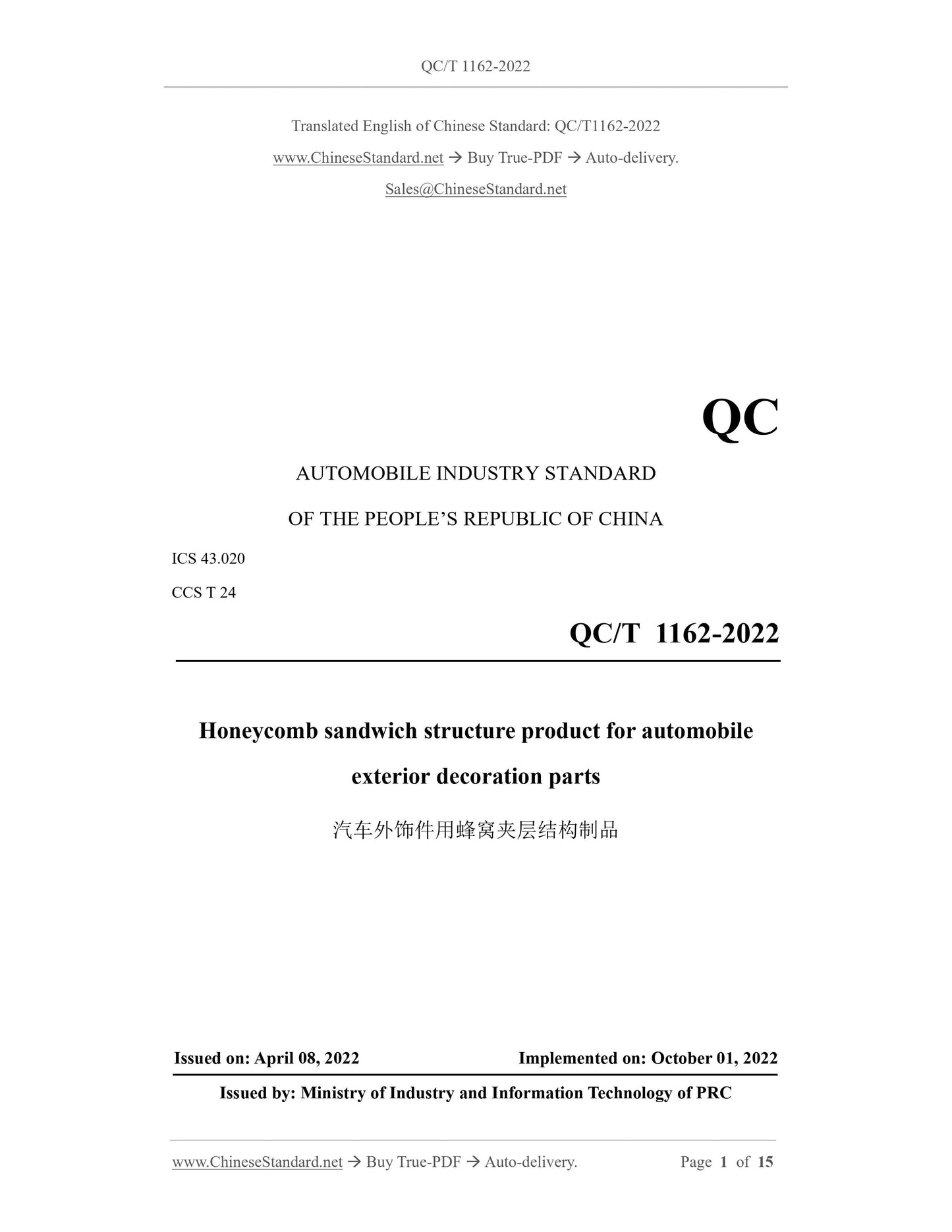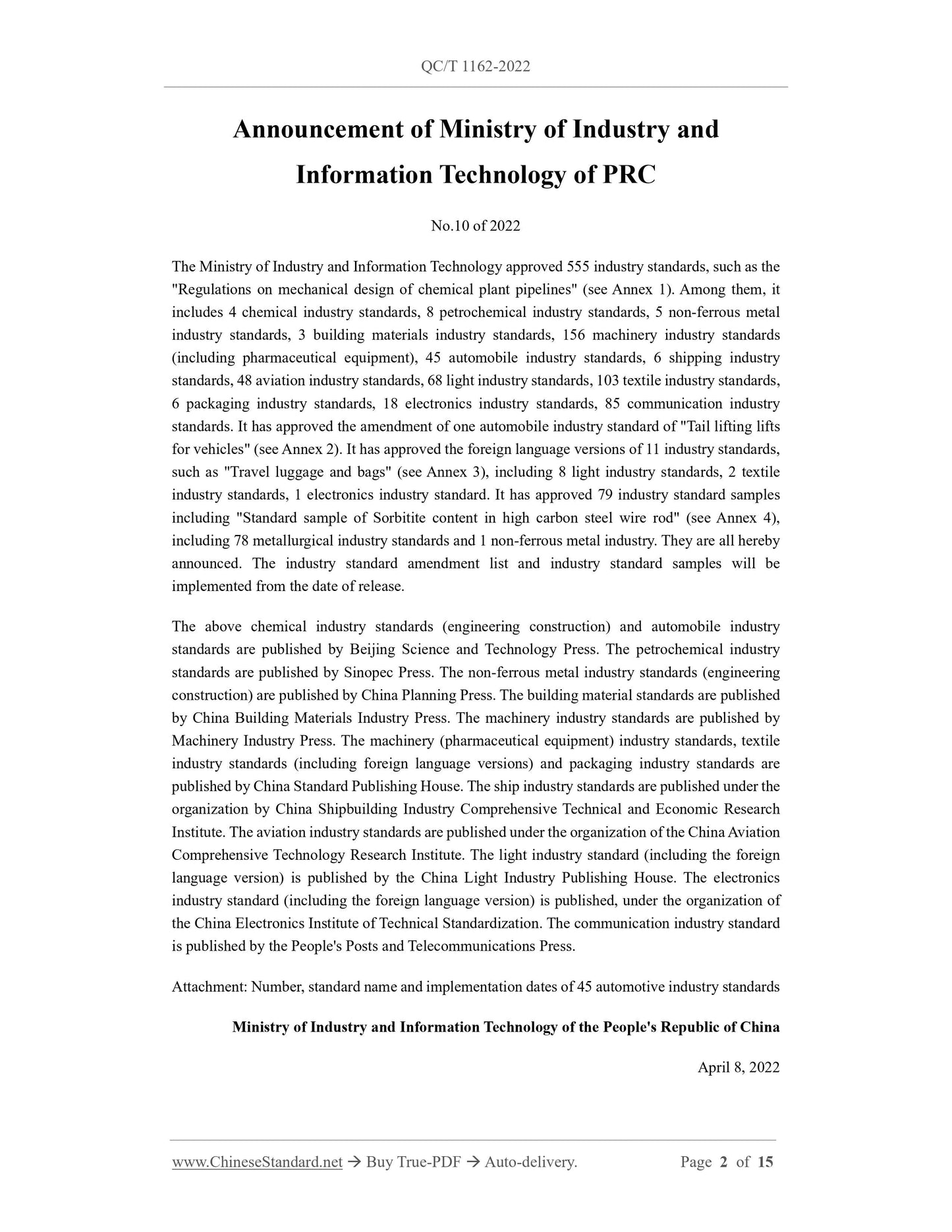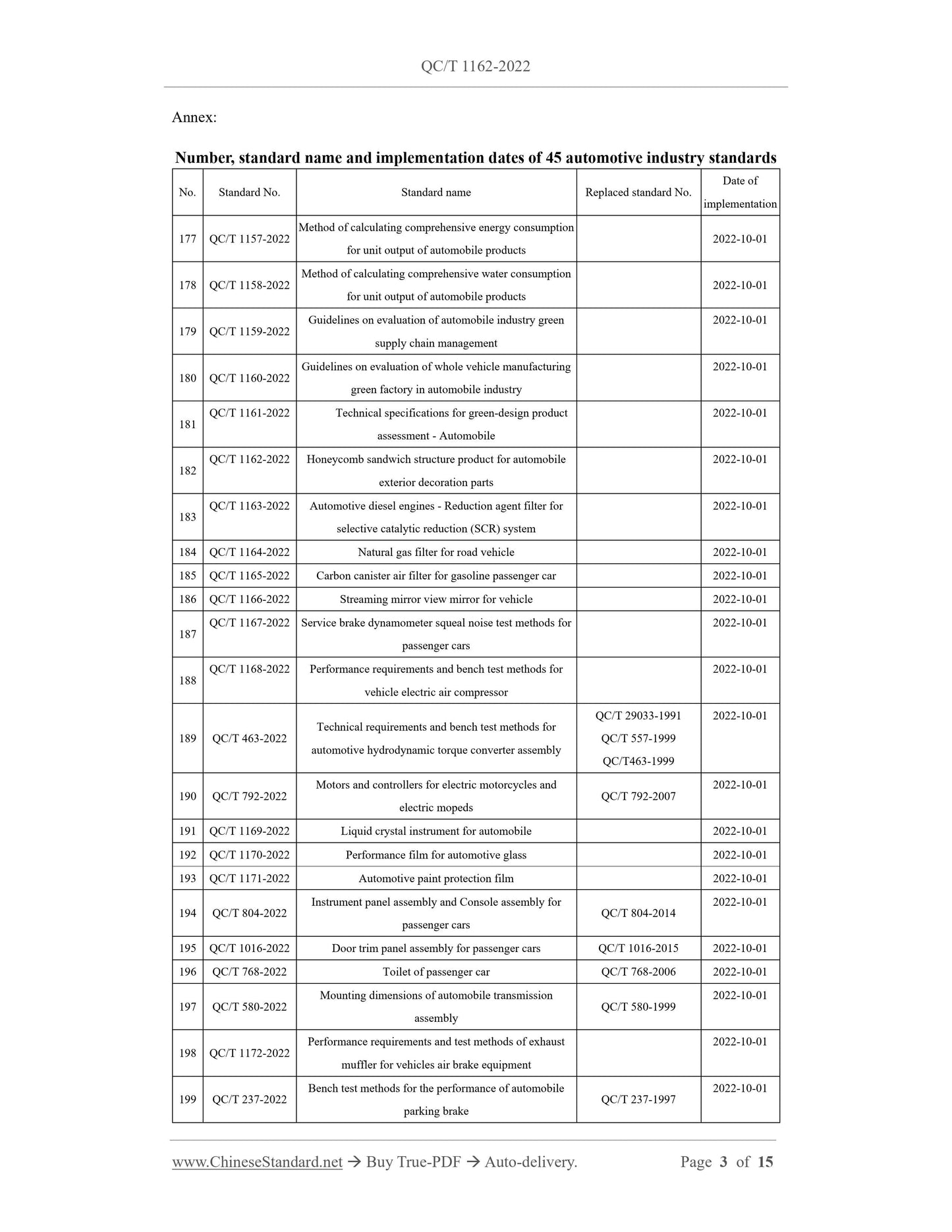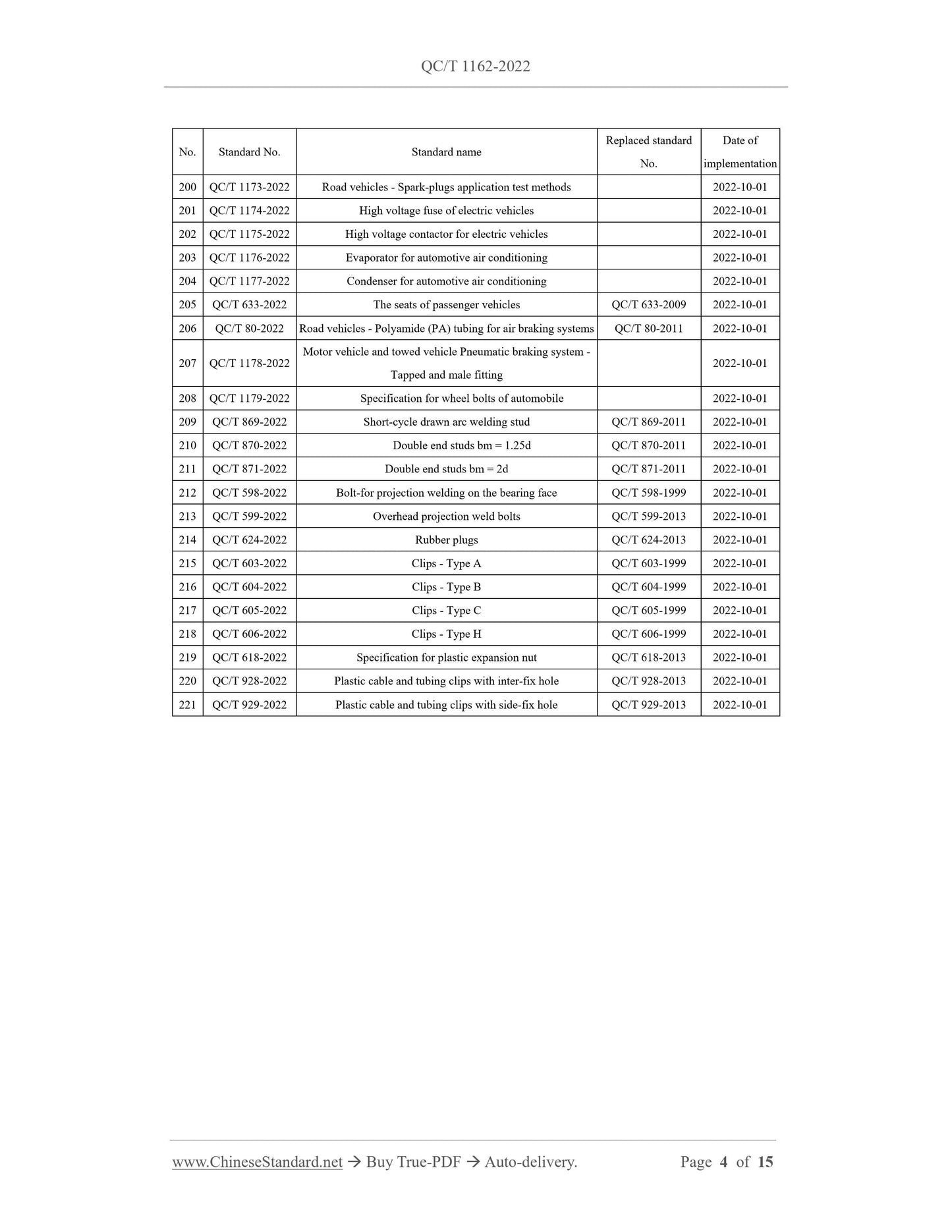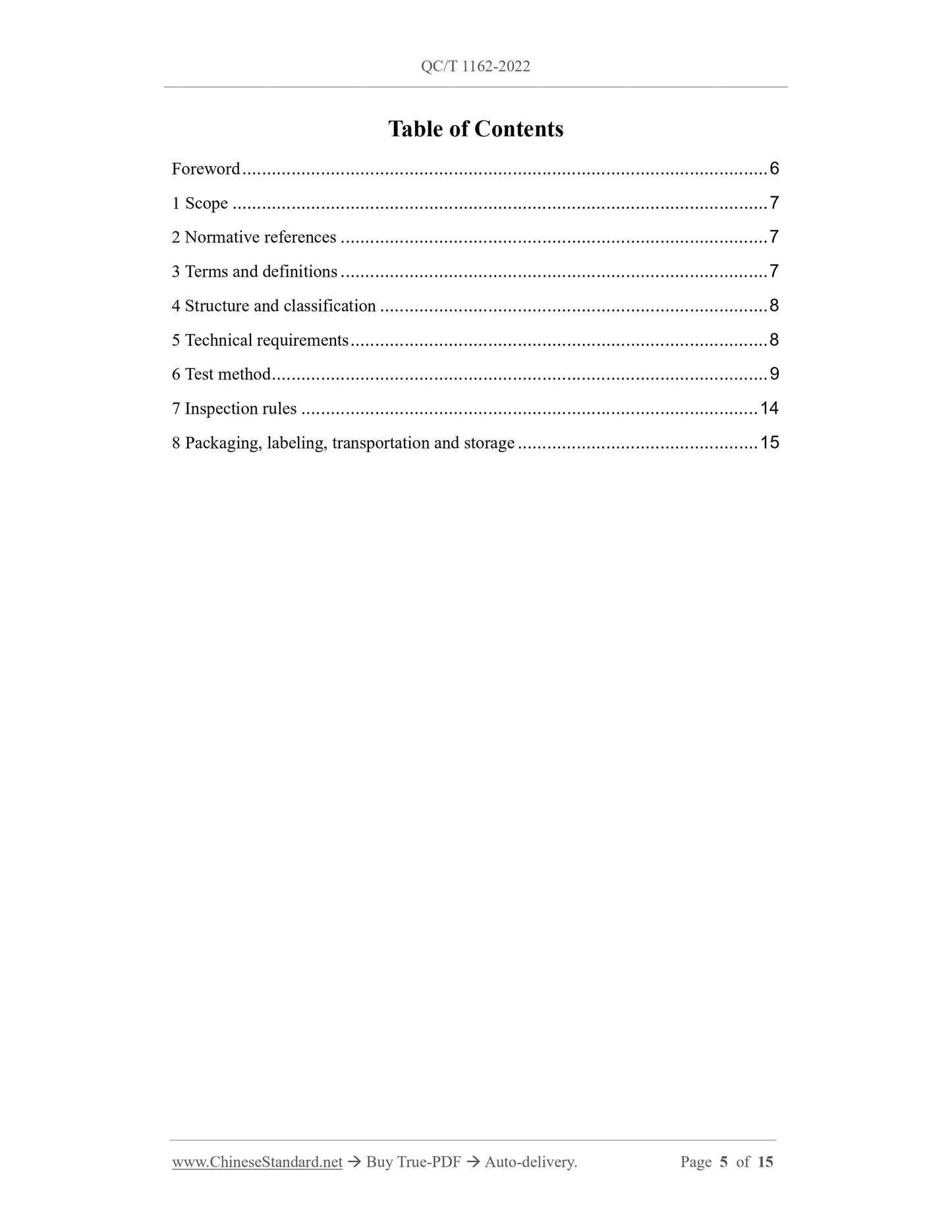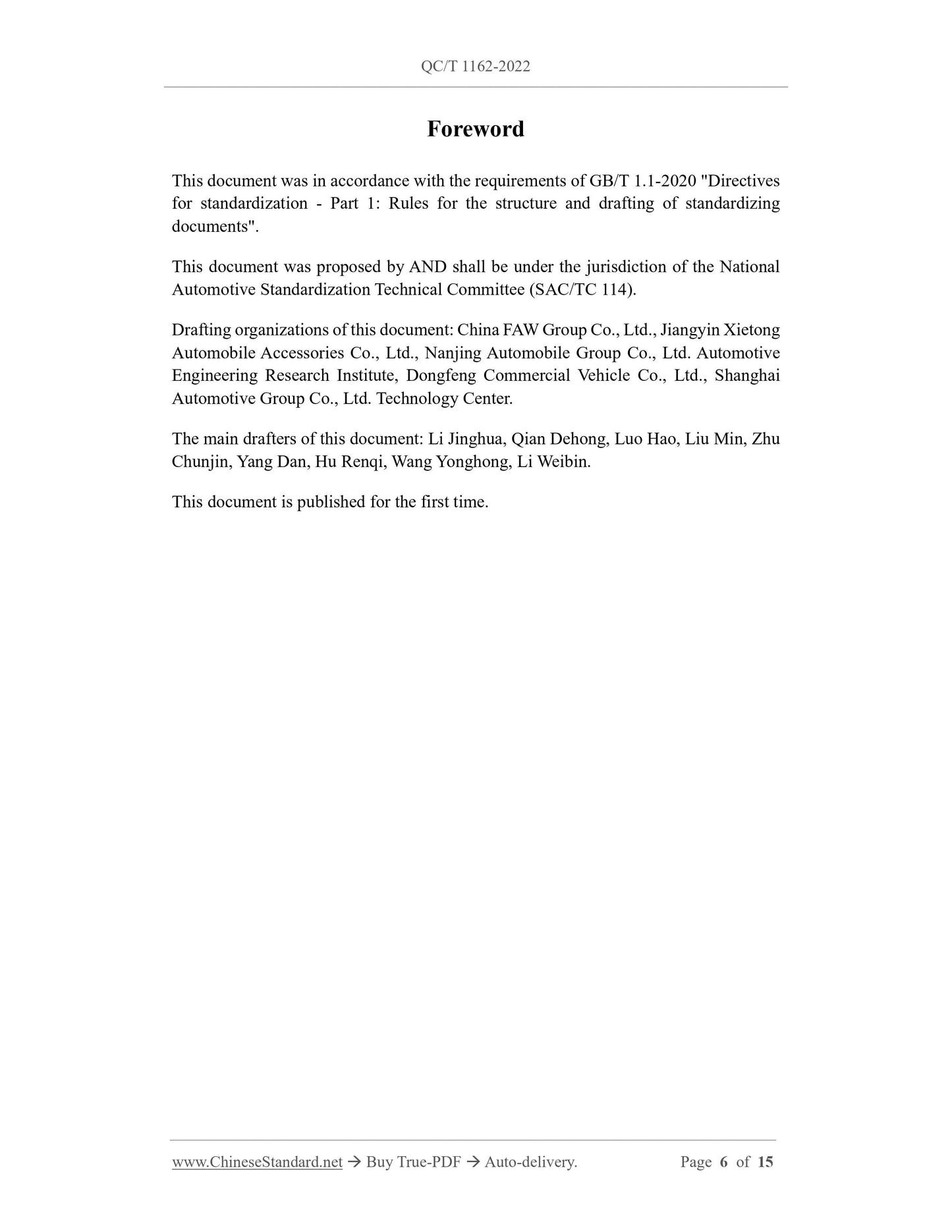1
/
af
6
PayPal, credit cards. Download editable-PDF and invoice in 1 second!
QC/T 1162-2022 English PDF (QCT1162-2022)
QC/T 1162-2022 English PDF (QCT1162-2022)
Normalpris
$185.00 USD
Normalpris
Udsalgspris
$185.00 USD
Stykpris
/
pr.
Levering beregnes ved betaling.
Tilgængelighed for afhentning kunne ikke indlæses
Delivery: 3 seconds. Download true-PDF + Invoice.
Get QUOTATION in 1-minute: Click QC/T 1162-2022
Historical versions: QC/T 1162-2022
Preview True-PDF (Reload/Scroll if blank)
QC/T 1162-2022: Honeycomb sandwich structure product for automobile exterior decoration parts
QC/T 1162-2022
QC
AUTOMOBILE INDUSTRY STANDARD
OF THE PEOPLE’S REPUBLIC OF CHINA
ICS 43.020
CCS T 24
Honeycomb sandwich structure product for automobile
exterior decoration parts
ISSUED ON: APRIL 08, 2022
IMPLEMENTED ON: OCTOBER 01, 2022
Issued by: Ministry of Industry and Information Technology of PRC
Table of Contents
Foreword ... 6
1 Scope ... 7
2 Normative references ... 7
3 Terms and definitions ... 7
4 Structure and classification ... 8
5 Technical requirements ... 8
6 Test method ... 9
7 Inspection rules ... 14
8 Packaging, labeling, transportation and storage ... 15
Honeycomb sandwich structure product for automobile
exterior decoration parts
1 Scope
This document specifies the structure and classification, technical requirements, test
methods, inspection rules, packaging, labeling, transportation and storage of
honeycomb sandwich structure products for automotive exterior decoration parts.
This document is applicable to compression-molded honeycomb sandwich structure
products for automotive exterior decoration parts, such as battery covers, roof shrouds,
door trim panels, etc.
2 Normative references
The contents of the following documents constitute the essential provisions of this
document through normative references in the text. Among them, for dated references,
only the version corresponding to the date is applicable to this document; for undated
references, the latest version (including all amendments) is applicable to this document.
GB/T 250 Textiles - Tests for colour fastness - Grey scale for assessing change in
colour
GB/T 1456-2005 Test method for flexural properties of sandwich constructions
GB/T 16422.2-2014 Plastics - Methods of exposure to laboratory light sources - Part
2: Xenon-arc sources
QC/T 15-1992 General test method for automobile plastic products
3 Terms and definitions
The following terms and definitions apply to this document.
3.1
Damage load
The force value, at which a specimen is damaged, when it is subject to the bending
strength test, according to the provisions of GB/T 1456-2005.
3.2
Flexure stiffness
The ability of a specimen to resist deformation, under a bending load.
4 Structure and classification
4.1 Structure
Honeycomb sandwich structure products for exterior decoration parts are composed of:
exterior panels (ABS, ASA, PC/ABS, PMMA and other materials or composite panels
composed of two or more materials), glass fiber reinforced polyurethane foam materials,
honeycomb core material (paper honeycomb, polypropylene honeycomb, aluminum
honeycomb or other honeycomb structure materials), etc.
4.2 Classification
Honeycomb sandwich products are divided into the following three categories,
according to the mass per unit area:
- Category a: Products which have a mass per unit area of less than 3000 g/m2 AND
are suitable for products with a bending stiffness higher than 9 x 106 N·mm2, such
as battery covers, etc.;
- Category b: Products which have a mass per unit area of 3000 g/m2 ~ 4500 g/m2
AND are suitable for products with a bending stiffness higher than 12 x 106 N·mm2,
such as roof spoilers, side spoilers, engine compartment covers, etc.;
- Category c: Products which have a mass per unit area greater than 4500 g/m2 AND
are suitable for products with a bending stiffness higher than 14 x 106 N • mm2,
such as lower door trim panels, top covers, rear doors, etc.
5 Technical requirements
5.1 Appearance quality
The outer surface of the product shall be smooth and flat, without defects such as
collapse and cracks, or other defects that affect the service life.
5.2 Product performance
Product properties shall meet the requirements of Table 1.
Carry out the test, in accordance with the provisions of GB/T 1456-2005. The test speed
is 2 mm/min ~ 5 mm/min. Record the maximum failure load. Take the arithmetic mean
of 5 test data. Round the result to an integer.
6.4.2 Room temperature
Take a pretreated product. Conduct the test, according to the requirements of 6.4.1, at
23 °C ± 2 °C.
6.4.3 Long-term heat resistance
Take a pretreated product and place it in an incubator at 80 °C ± 2 °C for 168 hours.
After taking it out, place it in an environment of 23 °C ± 2 °C for 0.5 hours. Conduct
the test according to the requirements of 6.4.1.
6.4.4 Resistance to cyclic cold and heat
Take a pretreated product and put it in a high and low temperature test chamber. Take (80
± 2) °C x 4 h → (23 ± 2) °C x 1 h →(-40 ± 2) °C x 4 h → (23 ±2) °C x 1 h as one
cycle; carry out 4 cycles of tests. After taking it out, place it at 23 °C ± 2 °C for 0.5 h.
Carry out test, according to 6.4.1.
6.4.5 Damp resistance
According to the provisions of 5.4.2 in QC/T 15-1992, take a pretreated product and
put it in a humidity test chamber, at a temperature of 55 °C ± 2 °C and a relative
humidity of (95 ± 5)% for 168 h. After taking it out, place it in an environment of 23 °C
± 2 °C for 0.5 h. Conduct the test according to the requirements of 6.4.1.
6.5 Bending stiffness
6.5.1 Sampling method
Take 5 specimens from the test product. The sampling position shall be selected as far
as possible at a flat center position, which is more than 20 mm away from the edge. The
specimen size is as shown in Table 3. The length, width, thickness of the specimen are
accurately measured by a caliper which has an accuracy of 0.02 mm.
Table 3 -- Dimensions of specimens for bending stiffness
Unit in mm
Thickness Length Width Span
< 10 320 60 120
10 ~ 21 400 60 160
> 21 480 60 200
6.5.2 Test method
6.7 Resistance to cyclic cold and heat
6.7.1 Test method
Take three pretreated products and put them into the high and low temperature test
chamber. The test conditions are in accordance with the provisions in 6.4.4.
6.7.2 Appearance quality and dimensional change rate
Visually inspect the product for abnormal phenomena, such as deformation, warping,
delamination, etc. Test the dimensional change rate, according to the provisions in 6.6.3.
6.8 Damp resistance
6.8.1 Test method
Take three pretreated products and put them into the damp test chamber. The test
conditions are in accordance with the provisions in 6.4.5.
6.8.2 Appearance quality and dimensional change rate
Visually inspect the product for abnormal phenomena, such as deformation, warping,
delamination, etc. Test the dimensional change rate, according to the provisions in 6.6.3.
6.8.3 Weight change rate
Carry out the damp resistance test, according to the provisions in 6.4.5. Use weighing
tools, which have a division value not greater than 1 g, to weigh the pre-test mass and
post-test mass of the three products, respectively. Calculate according to formula (3).
The test results are taken as arithmetic mean of 3 test data. The result retains one
decimal place.
Where:
ε - Weight change rate, %;
m1 - The weight before the test, in grams (g)
m2 - The weight after the test, in grams (g).
6.9 Cold impact resistance
Take three pieces of pretreated products. Place them in a low-temperature box at -40 °C
± 2 °C for 24 h, according to the provisions of 5.1.4.3 in QC/T 15-1992. Take them out.
Within 5 s, use 500 g ± 10 g steel balls to impact the outer surface of the product, at a
Get QUOTATION in 1-minute: Click QC/T 1162-2022
Historical versions: QC/T 1162-2022
Preview True-PDF (Reload/Scroll if blank)
QC/T 1162-2022: Honeycomb sandwich structure product for automobile exterior decoration parts
QC/T 1162-2022
QC
AUTOMOBILE INDUSTRY STANDARD
OF THE PEOPLE’S REPUBLIC OF CHINA
ICS 43.020
CCS T 24
Honeycomb sandwich structure product for automobile
exterior decoration parts
ISSUED ON: APRIL 08, 2022
IMPLEMENTED ON: OCTOBER 01, 2022
Issued by: Ministry of Industry and Information Technology of PRC
Table of Contents
Foreword ... 6
1 Scope ... 7
2 Normative references ... 7
3 Terms and definitions ... 7
4 Structure and classification ... 8
5 Technical requirements ... 8
6 Test method ... 9
7 Inspection rules ... 14
8 Packaging, labeling, transportation and storage ... 15
Honeycomb sandwich structure product for automobile
exterior decoration parts
1 Scope
This document specifies the structure and classification, technical requirements, test
methods, inspection rules, packaging, labeling, transportation and storage of
honeycomb sandwich structure products for automotive exterior decoration parts.
This document is applicable to compression-molded honeycomb sandwich structure
products for automotive exterior decoration parts, such as battery covers, roof shrouds,
door trim panels, etc.
2 Normative references
The contents of the following documents constitute the essential provisions of this
document through normative references in the text. Among them, for dated references,
only the version corresponding to the date is applicable to this document; for undated
references, the latest version (including all amendments) is applicable to this document.
GB/T 250 Textiles - Tests for colour fastness - Grey scale for assessing change in
colour
GB/T 1456-2005 Test method for flexural properties of sandwich constructions
GB/T 16422.2-2014 Plastics - Methods of exposure to laboratory light sources - Part
2: Xenon-arc sources
QC/T 15-1992 General test method for automobile plastic products
3 Terms and definitions
The following terms and definitions apply to this document.
3.1
Damage load
The force value, at which a specimen is damaged, when it is subject to the bending
strength test, according to the provisions of GB/T 1456-2005.
3.2
Flexure stiffness
The ability of a specimen to resist deformation, under a bending load.
4 Structure and classification
4.1 Structure
Honeycomb sandwich structure products for exterior decoration parts are composed of:
exterior panels (ABS, ASA, PC/ABS, PMMA and other materials or composite panels
composed of two or more materials), glass fiber reinforced polyurethane foam materials,
honeycomb core material (paper honeycomb, polypropylene honeycomb, aluminum
honeycomb or other honeycomb structure materials), etc.
4.2 Classification
Honeycomb sandwich products are divided into the following three categories,
according to the mass per unit area:
- Category a: Products which have a mass per unit area of less than 3000 g/m2 AND
are suitable for products with a bending stiffness higher than 9 x 106 N·mm2, such
as battery covers, etc.;
- Category b: Products which have a mass per unit area of 3000 g/m2 ~ 4500 g/m2
AND are suitable for products with a bending stiffness higher than 12 x 106 N·mm2,
such as roof spoilers, side spoilers, engine compartment covers, etc.;
- Category c: Products which have a mass per unit area greater than 4500 g/m2 AND
are suitable for products with a bending stiffness higher than 14 x 106 N • mm2,
such as lower door trim panels, top covers, rear doors, etc.
5 Technical requirements
5.1 Appearance quality
The outer surface of the product shall be smooth and flat, without defects such as
collapse and cracks, or other defects that affect the service life.
5.2 Product performance
Product properties shall meet the requirements of Table 1.
Carry out the test, in accordance with the provisions of GB/T 1456-2005. The test speed
is 2 mm/min ~ 5 mm/min. Record the maximum failure load. Take the arithmetic mean
of 5 test data. Round the result to an integer.
6.4.2 Room temperature
Take a pretreated product. Conduct the test, according to the requirements of 6.4.1, at
23 °C ± 2 °C.
6.4.3 Long-term heat resistance
Take a pretreated product and place it in an incubator at 80 °C ± 2 °C for 168 hours.
After taking it out, place it in an environment of 23 °C ± 2 °C for 0.5 hours. Conduct
the test according to the requirements of 6.4.1.
6.4.4 Resistance to cyclic cold and heat
Take a pretreated product and put it in a high and low temperature test chamber. Take (80
± 2) °C x 4 h → (23 ± 2) °C x 1 h →(-40 ± 2) °C x 4 h → (23 ±2) °C x 1 h as one
cycle; carry out 4 cycles of tests. After taking it out, place it at 23 °C ± 2 °C for 0.5 h.
Carry out test, according to 6.4.1.
6.4.5 Damp resistance
According to the provisions of 5.4.2 in QC/T 15-1992, take a pretreated product and
put it in a humidity test chamber, at a temperature of 55 °C ± 2 °C and a relative
humidity of (95 ± 5)% for 168 h. After taking it out, place it in an environment of 23 °C
± 2 °C for 0.5 h. Conduct the test according to the requirements of 6.4.1.
6.5 Bending stiffness
6.5.1 Sampling method
Take 5 specimens from the test product. The sampling position shall be selected as far
as possible at a flat center position, which is more than 20 mm away from the edge. The
specimen size is as shown in Table 3. The length, width, thickness of the specimen are
accurately measured by a caliper which has an accuracy of 0.02 mm.
Table 3 -- Dimensions of specimens for bending stiffness
Unit in mm
Thickness Length Width Span
< 10 320 60 120
10 ~ 21 400 60 160
> 21 480 60 200
6.5.2 Test method
6.7 Resistance to cyclic cold and heat
6.7.1 Test method
Take three pretreated products and put them into the high and low temperature test
chamber. The test conditions are in accordance with the provisions in 6.4.4.
6.7.2 Appearance quality and dimensional change rate
Visually inspect the product for abnormal phenomena, such as deformation, warping,
delamination, etc. Test the dimensional change rate, according to the provisions in 6.6.3.
6.8 Damp resistance
6.8.1 Test method
Take three pretreated products and put them into the damp test chamber. The test
conditions are in accordance with the provisions in 6.4.5.
6.8.2 Appearance quality and dimensional change rate
Visually inspect the product for abnormal phenomena, such as deformation, warping,
delamination, etc. Test the dimensional change rate, according to the provisions in 6.6.3.
6.8.3 Weight change rate
Carry out the damp resistance test, according to the provisions in 6.4.5. Use weighing
tools, which have a division value not greater than 1 g, to weigh the pre-test mass and
post-test mass of the three products, respectively. Calculate according to formula (3).
The test results are taken as arithmetic mean of 3 test data. The result retains one
decimal place.
Where:
ε - Weight change rate, %;
m1 - The weight before the test, in grams (g)
m2 - The weight after the test, in grams (g).
6.9 Cold impact resistance
Take three pieces of pretreated products. Place them in a low-temperature box at -40 °C
± 2 °C for 24 h, according to the provisions of 5.1.4.3 in QC/T 15-1992. Take them out.
Within 5 s, use 500 g ± 10 g steel balls to impact the outer surface of the product, at a
Share
